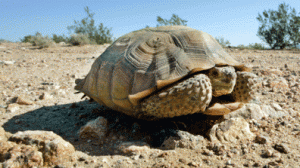
Wildlife biologists are concerned because the region has a rich biodiversity and includes many endangered or protected species, including the Agassiz and Morafka’s desert tortoise. These turtles dig burrows that shelter other organisms.
Solar energy facilities are poised for rapid development and could cover hundreds of thousands of hectares. Assessments of their effects should count both onsite and offsite effects and include construction and decommissioning as well as the operational phase, said Jeffrey E. Lovich and Joshua R. Ennen, the authors of the article. They highlight there are almost no peer-reviewed studies on the impacts of solar installations specifically carried out so far.
They are concerned with habitat fragmentation caused by roads and power lines, which could restrict gene flow, as well as the production of large amounts of dust through ground-disturbance. Solar plants are also expected to release pollutants such as dust suppressants, rust suppressants, and antifreeze, both in routine operation as well as through spills. They will predictably generate heat, electromagnetic fields, noise, polarized light, and possibly ignite fires. Evaporative ponds, which concentrate toxins, may be used and are a recognized hazard to wildlife. Because wet-cooled turbines need to be supplied with large amounts of water, developers are leaning toward using dry-cooled turbines, but these have a larger “footprint” than wet-cooled ones.
They added that the dearth of reliable information signals an urgent need for careful, controlled, pre- and post-construction studies of the effects of solar power plants in the Southwest. Such studies could attempt to determine information useful for optimally siting the plants, such as whether damage is minimized if they are concentrated in a few places or dispersed, as well as suggest preferred locations and mitigation possibilities.
We are unwavering champions of solar power, especially small scale rooftop installations. But utility-scale farms have to be carefully planned and should not pose a threat to wildlife and ecosystems. This story echoes the current controversy in Brazil, where the construction of a hydropower plant in the Amazon, which will flood hundreds of square miles of forests and displace 40,000 Indigenous people, has become a cause célèbre in the country. Hydro is also seen as a green type of energy, but surely not when it can wreak so much havoc.
You should follow us here.






We need to extract our inner Viking if we want to save the planet!
Our modern lifestyle has greatly reduced our connection and symbiotic relationship with nature and we may be standing at the brim of much destruction. The below 2 minute film link looks back at a time when our connection to the land also meant great respect for nature as expressed by Icelandic viking poems that accompany the visuals from an ancient Scandinavian warrior burial site.
http://dragonawardnewtalent.com/en-us/filmview/land-of-the-asers/